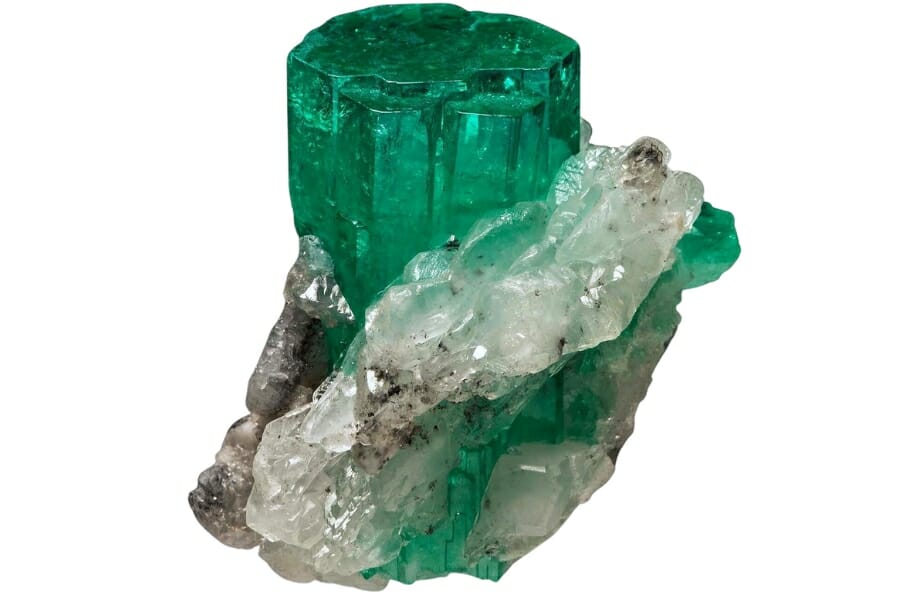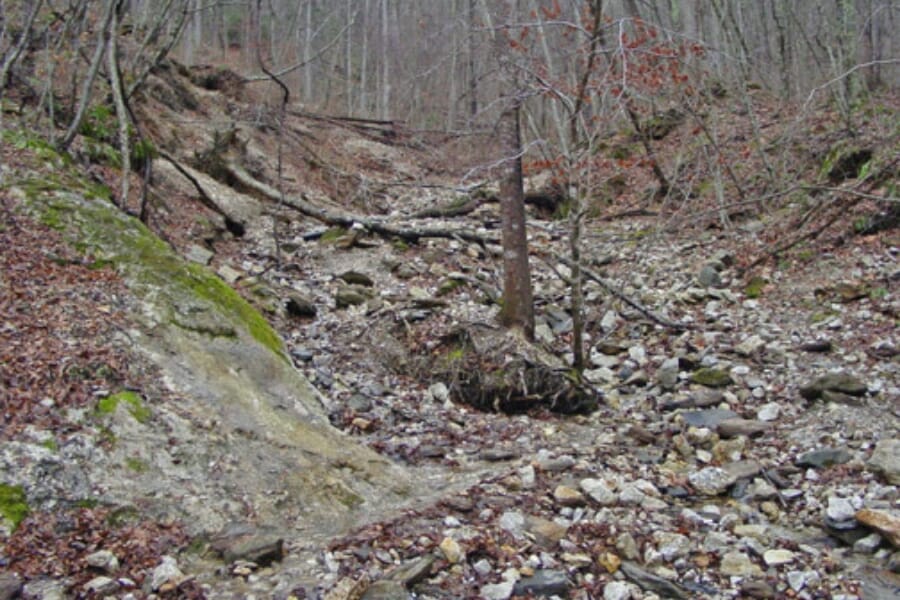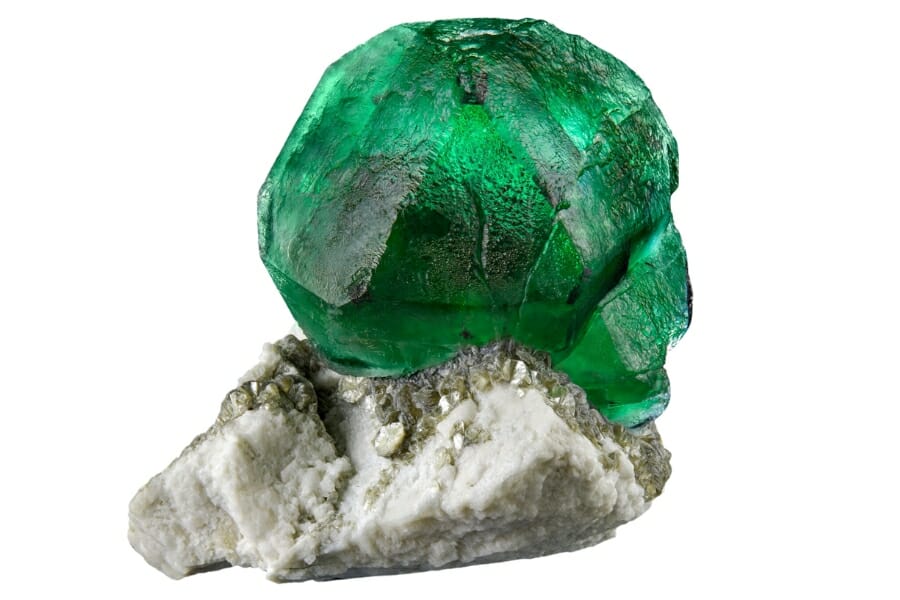Emeralds are some of the most sought-after gems in the world. Their beautiful deep green color is thought to represent rebirth and love. Emeralds are made from a mineral called beryl.
When chromium, vanadium, and iron are present, the mineral changes into an emerald, which gives it its unique green color.
These valuable stones can be found worldwide, but there are a few places in the US where gem hunters and hobbyists might find these green treasures.
We will advise you on spotting possible emeralds and tell them apart from less valuable green stones. Whether you’re a hobbyist who wants to feel the thrill of discovery or an experienced gem collector, our guide will help you on your exciting quest to find the emerald, nature’s green masterpiece!
What is Emerald?

Emerald is a valuable stone that is known for its deep green color. It’s a beryl mineral, and its color comes from chromium and vanadium.
These gems are formed under a lot of heat and pressure in metamorphic rocks, and you can sometimes find them in pegmatites.
Emeralds are mostly found in Colombia, Brazil, and Zambia but also in Russia, Afghanistan, the United States, and other places.
Their formation needs special rock conditions, so real emeralds are rare and valuable.
The different types of Emerald
Emeralds are valued for their beautiful, lush green colors. However, they vary in color, clarity, and origin, so several types are known worldwide.
Each type has unique traits from the geological conditions of the place where it formed. These differences affect not only how the gemstone looks but also how much it’s worth and how much collectors and enthusiasts want it.
Brazilian Emerald

Because they contain small amounts of iron, Brazilian emeralds have a unique yellow-green color that makes them stand out from Colombian stones, which are a deep green.
These gems usually have a different kind of beauty because they are lighter, clearer, and have fewer flaws. Most of Brazil’s emeralds are found in Bahia, Goiás, and Minas Gerais. Minas Gerais is one of the world’s most important gem-producing areas.
Brazilian emeralds are usually found in phlogopite schist, giving them unique color and clarity. Their different qualities appeal to people who want different quality and appearance options.
Colombian Emerald

Colombian emeralds are famous worldwide for their unique bright green color, which often has a slight bluish tint. This is because the area’s geology makes it ideal for chromium and vanadium to be present.
Most of these valuable stones are found in the departments of Boyacá and Cundinamarca in the Eastern Ranges of the Colombian Andes. Compared to emeralds from other places, they are different not only because of their bright color but also because of how clear and fiery they are.
Colombian emeralds, often found in calcite deposits, are some of the world’s most valuable and sought-after gems. They have set the standard for quality.
Ethiopian Emerald

Recently discovered Ethiopian emeralds have wowed the gemstone world with their stunning clarity and unique bluish-green to pure green colors caused by vanadium and chromium.
Most emeralds come from the Seba Boru district in the southern part of the country and close to Shakiso.
Unlike their Colombian counterparts, which are usually found in carbonate rocks, Ethiopian emeralds are found in biotite schist and quartz veins, giving them unique qualities.
Even though they are newer to the market, the stones’ bright color and high level of transparency quickly make them more valuable and sought after by collectors and gem experts.
Russian Emerald

People love Russian emeralds because they are a deep green color often similar to the highly sought-after shades of Colombian emeralds but with a clear bluish tint.
These emeralds were traditionally found in the Ural Mountains, especially in the Tokovaya mines near Ekaterinburg. They differ from emeralds from South America because they have a high iron content instead of chromium and vanadium.
This composition makes the colors brighter and clearer, but they are spread out slightly differently.
Even though Russian emerald mines don’t produce as many as mines in Colombia or Zambia, they are historically significant, and the fact that they are so rare and of such high quality makes them highly sought after on the world market.
Trapiche Emerald

Trapiche emeralds are rare and known for having a pattern resembling a six-spoke wheel. These patterns happen because the gem is split up by black carbon impurities that stand out sharply against the lush green of the emerald parts.
Most of them are found in Colombia, mostly in the Boyacá and Cundinamarca departments, which are known for having the best emeralds in the world.
Unlike most emeralds, trapiche emeralds form in special geological conditions where the gem crystallizes around black carbon that was already there.
This gives them the star-like pattern that sets them apart from other emeralds, which makes collectors and enthusiasts want them for their uniqueness.
Zambian Emerald

Zambian emeralds are stunning because of their deep, rich green color, which often has a bluish tint. This makes them stand out from emeralds from other areas with warmer colors.
These gems are mostly found in the Kafubu River area in the Ndola Rural Restricted Area. They are renowned for being clear and transparent because they have less iron than Brazilian emeralds.
Their unique features come from the fact that they form in the beryl family of minerals, specifically in pegmatite and talc-magnetite schist.
Even though they are newer to the market than emeralds from Colombia, Zambian emeralds are valued for their strong color, few inclusions, and durability, making gem lovers worldwide want them more and more.
Where to find Emerald
In the United States, people who want to find emeralds have to go on an exciting journey through certain places known for their geological ability to hold these green gems.
We will detail the most famous places and mines where these valuable stones can be found, giving you new information on where to find them!
Emerald Hollow Mine, North Carolina

As the only public place in the US to look for emeralds, the Emerald Hollow Mine in Hiddenite, North Carolina, is a gem lover’s dream.
Located in the Brushy Mountains, this spot is surrounded by more than 60 types of naturally occurring gems and minerals, making it a popular spot for gem hunting.
You can find different kinds of emeralds here, from the common deep green stones to the rare and highly sought-after blue-green ones.
As a result of the site’s unique geological makeup, which includes hiddenite (a green variety of spodumene) and other minerals, these valuable stones grow. This makes the experience unbeatable for both casual rockhounds and serious collectors.
Hogg Mine, Georgia

Hogg Mine in LaGrange, Georgia, is a famous place for gem hunters to visit, but it’s not mostly known for finding emeralds. It’s known for having a lot of other valuable minerals, such as aquamarine, star rose quartz, black tourmaline, and the rare blue beryl.
Even though the mine doesn’t have a lot of emeralds, its varied geology means that surprises are possible, and prospectors may find the green variety of beryl. Hogg Mine draws people in with the chance to dig for themselves and the thrill of finding gemstones.
Even though emeralds aren’t usually found here, the site shows what an exciting time it can be to look for gems.
Morefield Mine, Virginia

Morefield Gem Mine in Amelia, Virginia, is a famous place for gem hunters to visit, but it’s not mostly known for finding emeralds. People see the mine for having a lot of amazonite, garnets, and more than 80 other minerals.
Even though emeralds are hard to find, the mine’s wide range of rocks means that new ones can always be found. Prospectors may even find types of beryl, which is a mineral that is related to emeralds.
Morefield Gem Mine is appealing because it offers adventure and the chance to find hidden treasures. This makes it an excellent place for hobbyists and serious collectors who want to go gem-hunting with their own hands.
North American Emerald Mine, North Carolina

The North American Emerald Mine (NAEM), in Hiddenite, North Carolina, is known worldwide for having some of the best and biggest emeralds ever found in North America.
The mine is famous for its high-quality emeralds that are very clear and deep green. It has produced many significant finds, such as the famous “Carolina Emperor,” one of the most enormous emeralds ever found in North America.
Because of the unique geological conditions in the Hiddenite area, the emeralds from NAEM are known for their unique bluish-green to yellowish-green colors.
The mine isn’t open to the public for digging, but its history and contributions to the field of gemology make North Carolina a significant source of these rare green gems.
Ray Mica Mine, North Carolina

The Ray Mica Mine in Yancey County, North Carolina, is better known for its large amounts of mica and other minerals like feldspar than its emerald production.
Sheet and scrap mica were taken out of the ground in large amounts. Mineral collectors and hobbyists love the area because they can surface, collect and dig through the mine’s dumps.
Even though emeralds aren’t common here, the mine’s wide range of minerals, significantly different kinds of mica, makes it a great place to learn about geological treasures unique to North Carolina.
How to find Emerald
There are many ways to search for emeralds. You can find one of these beautiful stones on every new path. Let’s take a closer look!
Examine color and transparency
To identify emeralds, you need to pay close attention to their color and clarity, two of their most distinctive qualities. The bright, deep green color of an emerald makes it unique.
The color can range from pure green to a greenish-blue. The most sought-after emeralds have a bright color that isn’t too darkened by gray or brown. Another vital quality of emeralds is their “diaphaneity,” or ability to let light pass through them.
Once you know what kind of stone it is by looking at its color and clarity, you should look around more carefully because emeralds are often found in groups or clusters within the same geological formation.
Inspect inclusions
Within emeralds, tiny flaws are called inclusions, sometimes called the stone’s “jardin,” which comes from the French word for “garden” because they look like plants.
These inclusions show where the stone came from naturally and tell us something about the conditions in which the emerald formed. Under a microscope, you can see common inclusions, which look like tiny bubbles, cracks, or mineral deposits.
Because inclusions are so common in emeralds, a completely clear stone might need to be checked to ensure it’s real.
Test the hardness
Testing its hardness is one sure way to tell if something is an emerald. Emeralds are beryl and have a Mohs hardness of 7.5 to 8.
This means they are strong enough to resist scratches from soft materials, but they can also show signs of wear if they are handled roughly or hit with harder objects.
This feature can help tell emeralds apart from gemstones with a lower hardness that look like green apatite. When prospecting, a hardness test can be the first thing done to ensure that an emerald is real once it’s found.
With a pocket hardness kit, you can do a scratch test on a real stone by starting with a known reference mineral with the same hardness or slightly less hard. It might be an emerald if the stone is hard to scratch.
How to identify Emerald once you find it
Emeralds are unique because they are not like other gems in many ways. Let’s talk about how to spot an emerald stone in a pile of other stones.
What Emerald looks like on the outside
Depending on the type, the outside of an emerald can look very different. Here are some general things to look for:
Matrix

Rough emeralds have a matrix around them that shows where they came from naturally. This matrix often has a messy, unassuming appearance that hides the gem’s bright beauty.
Most emeralds are found in a host rock. This rock can be black shale, limestone, or pegmatite, an igneous rock. The matrix is usually cloudy and has veins or spots of a different color, usually white or quartz-like, black from biotite, or shiny from mica.
Some of these rocks are rough and crumbly and may contain other minerals. The emeralds could be completely hidden inside the rock or peek out through the matrix and show off their beautiful green color.
Cracks or holes in the matrix could be signs of the crystal treasures inside. The rough, unpolished outside looks very different from the polished gems in a jewelry store.
Shape and size

Rough emeralds have a unique, rough beauty that differs significantly from their cut and polished counterparts. They look beautiful just as they came out of the ground, without any processing.
Rough emeralds come in a huge range of sizes, from very small pieces that are only a few millimeters long to very rare fist-sized stones that can weigh hundreds of carats.
Their surfaces are often not smooth because the forces at work distorted the crystal’s natural shape when it formed, giving it a jagged, disorganized look.
Even though the outside of a good rough emerald is rough, you can still see hints of its transparency; the green color can be seen through the rough surfaces.
The amazing geological processes that made these precious stones possible can be seen in their unique features.
Surface texture

How an emerald’s surface feels shows how it got from deep inside the earth to the light of day. Rough emeralds have an unrefined, natural beauty different from finished gemstones’ polished shine.
Their outside is often rough and uneven, with natural cracks, pits, and a granular feel from the extreme temperatures and geological pressures they’ve been through. Depending on how they formed, these crystals may have striations running along their length or parts of their faces that are smooth.
You might feel the smooth planes and rough edges coming together when you touch a rough emerald. This is because the crystal’s natural cleavage and its more turbulent environmental interactions interact.
Real, unpolished gemstones have this kind of textural complexity that connects you to their deep earthly roots.
What Emerald looks like on the inside
Sometimes, the inside of an emerald looks a lot like the outside, but most of the time, the inside is brighter or more concentrated. You can see the following:
Crystal structure

The rough emerald’s crystal structure, hidden from view, is a beautiful work of symmetry and geometry. Emeralds are a mineral called beryl, and their crystals usually form columnar or elongated colorful crystals in a hexagonal system.
Inside, the gem’s crystal lattice comprises beryllium, aluminum, silicon, oxygen, and trace amounts of chromium or vanadium, which give it its distinctive green color.
These features—whether they’re fluid bubbles, mineral phases, or fissures—are part of how the stone formed naturally and are like fingerprints that show how each emerald’s geological history is unique.
Even though these things are inside, the structure stays straight and balanced, a silent sign of the systematic processes deep inside the Earth’s crust.
Fractures

Cracks are common inside a rough emerald and are thought to show the stone’s geological history.
These breaks, which are sometimes called “feathers” because they look like wispy strings, happen when the crystal forms, as it grows, and even when it’s inside the earth’s crust and is under stress.
Some cracks are so small that you can hardly see them with the naked eye, while others may be big enough to go through the crystal’s depth or width. These breaks inside the stone can bend light in strange ways, which can sometimes bring out its natural beauty.
But they also change how clear the stone is and how stable it is overall. Many people see these cracks as flaws, but gemologists and collectors often see them as natural features of a real emerald that reveal the extreme pressures and changes it underwent while forming deep in the earth.
Pleochroism

Emeralds have an engaging optical effect called pleochroism, meaning that the gem shows different colors from different angles. This is because the crystal absorbs light along different axes.
This feature is especially interesting inside a rough emerald. Depending on how the crystal faces the light source, different shades of green may become visible when it is rotated.
These shades are usually bluish-green, yellowish-green, and a pure verdant green. It has this property because emeralds have a hexagonal crystal structure and chromium and/or vanadium are present, which give the gem its rich color.
Pleochroism is a very important feature for gemologists to be able to tell the difference between stones.
Anyone working with emeralds needs to know about it because it helps them figure out the best way to cut the stone so that the color stands out the most.


